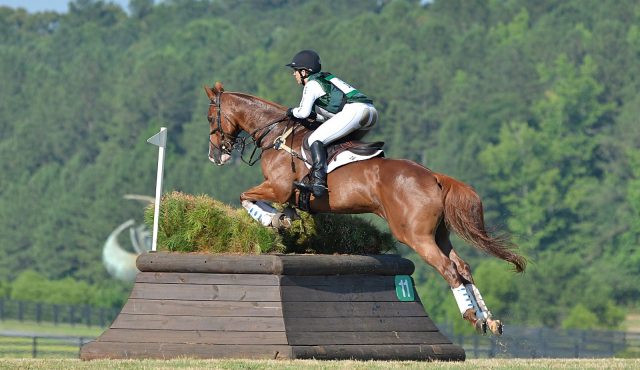What’s in Your Arena? is an EN series sponsored by Attwood Equestrian Surfaces in which riders share their favorite jumping exercises. It’s easy to get stuck in a training rut, and we hope this will inspire you with fresh ideas that you can take home and incorporate into your own programs. Have an exercise to share? Email it to [email protected]!
What is the meaning of life, the universe and everything? The answer, if you subscribe to truths put forth by Douglas Adams’ The Hitchhiker’s Guide to the Galaxy, is “42.” An effortlessly basic answer to a mind-twist of a question that has baffled thinking human beings for centuries. A two-digit number, which took a supercomputer purpose-designed to answer the question seven-and-a-half million years to deduce. Simply: 42.
In her most recent Bad Eventer blog post, two-star rider and noted eventing philosopher Laura Szeremi lights the fuse on this stick of cerebral dynamite:
Which is more important: having the right canter, or being able to see the distance?
A question that is basically the jumping equivalent of “What is the meaning of life, etc.” And when it comes to answering it, things can get pretty heated. We’ll let Laura take it from here (for the illustrated version, check out her original blog post):
“Without fail every single person I have ever lessoned with (and there have been quite a few in my *cough* four decades in this sport) has had a strong opinion on this subject.
“It’s just not a lukewarm area like … lettuce. Most people don’t get overly passionate about lettuce. They’ll eat it in a taco, or on a sandwich. But they won’t get their blood pressure up over loving or hating lettuce.

Photo via Wikimedia Commons/CC.
“But this canter vs distance concept? Holy cow — I’ve seen otherwise calm trainers cross over into frothing-at-the-mouth-zealots when discussing this topic.
“For many years I’ve had my own opinion on the subject, which is a complex equation relating rider skill to the size of the fence as compared to the scope of the horse.

Diagram by Laura Szeremi.
“But recently I had one of those I’m-an-idiot epiphanies and thought I might not be alone.
“Here’s the rub:
“What the hell is “the right canter”? And how on earth do you know when you have it?
“I had a jump school where things didn’t go quite perfectly.

“And while I was thinking about bits and lines and sensitive horses and all the things that seemed to be going wrong, the fearless leader steps in and says something like, ‘Your canter sucks, you were just hammering down to everything being Bad Eventer.’
“Wow.
“He hadn’t called me out on ‘being Bad Eventer’ in a LONG time.
“A quick perusal of articles on ‘the right canter’ gives me a lot of hocus pocus answers saying things like it’s ‘in the flat work,’ ‘it’s about an uphill balance,’ etc. Not that any of that is wrong, but it still doesn’t tell you how you know when you have that magical canter.
“That’s when I figured out that calling it ‘the right canter’ leads you down the wrong path.
“It has more to do with rhythm and adjustability than the canter itself. You can have a beautiful uphill canter on a 12′ stride and it’s still not the right canter if you ask the horse to move up or slow down and nothing happens.
“The other piece of the puzzle I only discovered when I changed horses … and this secret of the universe is that the canter can’t change unless you want it to.
“I was cantering around a tight turn to a fence, and for the first time in my life I saw that I was going to meet the fence perfectly before I had even made the turn.

Photo courtesy of Laura Szeremi.
“That had never happened before.
“It turns out that the WonderPony, as amazing as he was, never gave me the same stride to anything. He bombed around cross country like the epic XC machine he is.

Photo courtesy of Laura Szeremi.
“But our stadium demons were real.

Photo courtesy of Laura Szeremi.
“And now I know a big piece of that puzzle was that we never had a consistent stride.

Photo via Wikimedia Commons/CC.
“Sooooooo. Part of the elusive ‘right canter’ is one that doesn’t change unless you ask it to, and that changes immediately, when you ask it to.
“This exercise turned out to be more of the answer than I knew.”
Canter pole Olympics! Turned a 5 stride line into a 10 & a 3! #Boom #Zebrasaurus #BadEventer
Posted by BadEventer on Friday, January 27, 2017
“Canter pole Olympics! Turned a five-stride line into a 10 and a three!”
And there you have it, folks. Two canter poles, set 72′ apart. A galaxy of possibility. How many strides can you fit in or take away, while keeping the step length perfectly even? Do try this at home!
Go Eventing.



















